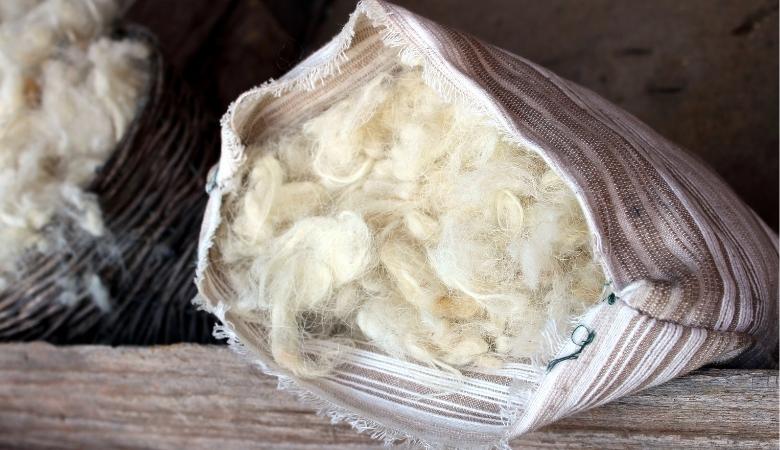This post is a part of the complete wool pillow buyers guide
Wool is a beautiful fiber with exceptional properties that other threads do not have. It is warm and maintains its warmth even when it is wet. Wool is equally a resilient material that does not break easily and takes dyes ideally.
All these properties explain why wool is one of the most preferred materials for making pillows. It can be spun to various thickness sizes to improve a pillow’s loft. These pillows are also priced fairly meaning anyone can buy them.
When you buy a wool pillow, you are assured of safety and longevity which is an advantage. Many sleepers would find them uncomfortable because they are stiff and even opt for different pillow types.
This should not be a matter of concern because you can quickly soften your wool pillow to be comfortable and supportive. Before we look into the details, first look at the type of wool used for making pillows.

Types of Wool Used in Pillows
The wool used for making pillows vary in shapes, fluffiness, softness, and services. There are various types of wool, including merino wool, sheep’s wool, mohair wool, cashmere wool—Angora wool, alpaca wool, etc.
Sheep wool is commonly used for making pillows because it is loftier and stays warm for more extended periods. This wool can either be natural or organic.
Wool can either be obtained from a lamb or a matured sheep. A lamb’s wool is thinner, white, and straight than mature sheep’s wool. Alternatively, adult sheep have thick wool that is either black, white, or brown with longer fibers.
These have moisture-wicking properties that allow temperature control.
Organic wool
Organic wool is mainly used because it is safer than other wool forms. This wool is also taken through safe production processes, from birth to shearing. The rearing and grazing fields of the sheep follow humane procedures that are GOTS-certified.
A GOTS-certified wool pillow is safe for children. However, the high demand for organic wool has increased dependence on natural wool fibers and ‘eco-wool.’
Why Are Wool Pillows Stiff?
Most mammals have scaly hair, and wool is not any different. Animal fiber is hairier, and it can be irritating to the skin. Wool undergoes softening processes during production but may still be stiff when packed in the pillow.
Many people complain about wool pillows being stiff and dense when they initially buy them.
It takes a long time for coarse fiber like wool to get soft. They bounce a lot and keep you in an elevated position. The fiber ends can also penetrate the pillow cover and poke you.
Wool softens depending on how much you use it and wash it. There are various ways to soften your wool pillow, and here are some standard techniques.
How to Soften a Wool Pillow

1. Exert pressure before sleeping on it
Not many people trust this technique, but it works. Wool fibers can break down their tight bonds when subject to pressure. The fibers loosen over time, and the pillow becomes softer.
When you do this on your wool pillow before sleeping on it, it will get softer within minutes.
Here is a quick guide on how to do it:
- Place your wool pillow on the floor, or the mattress provided it is a flat surface that provides cushioning.
- Use a pipe or a sock with a tennis ball and hit the pillow 2-4 times. Be careful not to overdo it because the pillow might lose its original shape. If you beat the bed’s pillow, you can also do this with your hand.
- You can also jump on the pillow a few times, turning it around to ensure you reach all sides and corners.
- Focus on the center of the pillow because that is usually the stiffest area and where you will be placing your head. Ensure it softens uniformly and repeat the process until it achieves the desired softness levels.
- Once the pillow is softened, fluff it for five minutes to make it comfortable.
This method is more straightforward, and you do not have to use any special tools.
2. Stuff the pillow
Regardless of your pillow having wool fillings, you can still stuff it with other materials to make it soft. Follow these steps when stuffing your pillow.
- Get a slightly bigger pillowcase and use it to cover your wool pillow. You can then add soft materials like polyester or cotton on the side you will be sleeping on. If you can access down or feather material, the better because you want to keep the pillow as organic as possible.
You can also add clothing or a towel if you cannot source any other material.
- Appropriately distribute the material to prevent the formation of clumps that make the pillow uncomfortable to lay on.
- The materials you use should be clean because the contaminated fabric could trigger allergies or cause skin outbreaks. Squeeze your pillow to ensure that the pillow is comfortable and malleable.
You can apply some heat or pressure to achieve better results.
3. Warm your pillow
Wool and down pillows can change their shape when exposed to heat. Wool, in particular, has temperature regulation capabilities that enable the pillows to soften over time. Here are some ways you can warm your wool pillow to be softer.
- If you have an electric blanket, use it to wrap the pillow and leave it in for 15 minutes. This process is quick and non-invasive.
- If you cannot access an electric blanket, place your pillow closer to the radiator or heater to absorb heat. Keep it some inches further from the heat source to avoid burning the pillow cover and the wool.
- Place your pillow over an ironing board and cover it with a towel. Set the iron and run it over the towel at medium heat to warm the pillow. Do not let the iron get hot until it burns your towel and pillow.
- Grab a hot water bottle and place it on the pillow for around 15 minutes. Change the bottle’s position after every five minutes to reach all parts.
- Place your wool pillow in a dryer on low heat for about 15 minutes until it gets warm. You can add a stuffed doll or tennis ball to beat up the pillow and make it softer.
Avoid using too much heat in any step that may require heating because it could burn your wool.
4. Air-dry it in the sun

Warming your pillow does not have to use special techniques or tools. You can leave it out in the sun to soften from natural heat. Ensure you follow these steps.
- Place your pillow on a flat surface outside the house in a place with sufficient airflow. Please check the pillow frequently and flip it over to soften both sides. This process also allows air circulation that gets rid of moisture and odors.
- If you do not want your pillow to fade from the sun’s heat, you can place it on a window where sun rays hit directly. The pillow absorbs indirect heat from the window panes that softens the wool materials.
Leave the pillow in the sun for three to four hours, and the pillow will be soft.
5. Washing the pillow
Some pillow brands use wool material that can be washed and dried in the washing machine. You can wash your wool pillow to break down the fibers and make it softer. This is what you need to do;
- Place the pillow in a washing machine with another pillow to prevent excessive bouncing.
- Use cold or warm water because hot water can further separate the fibers causing the pillow to form lumps.
- Wash it in a gentle cycle and add some conditioner or detergent to soften the wool.
- After washing the pillow on the first cycle, run the machine on a second cycle to rinse the pillow. The second cycle is essential because it removes the excess detergent and conditioner to keep your pillow fresh.
- When drying the pillow in a dryer, set it on low heat and place two tennis balls to beat up the pillow and soften it. If you do not have tennis balls, you can beat them with your hand after taking them out of the dryer.
6. Use your body temperature
When you sleep on a wool pillow with a warm body, the wool filling can absorb the heat and become loose. You can raise your body temperature by moving around or doing other physical activities that work for you.
You can also drink hot soup or any other beverages available at the moment. This gets your body warmed up in no time without undertaking training activities.
You must not do this every day. After a few days, you will realize your pillow is becoming soft.
7. Use the pillow regularly
A wool pillow may feel stiff when new because the filling is still tightly woven. If you are patient, you can let the pillow get soft by using it regularly. The more you sleep on it, the more the fibers break down and loosen.
Considering that you will be sleeping on this pillow every night, the weight of your head may take some time to achieve the desired level of softness. A comfortable pillow equates to enjoyable and restful sleep.
You should also try using the pillows in other ways besides supporting your head. You can use it to support your legs when sitting on the couch and apply pressure.
Wool is a durable and malleable material, staying more comfortable even after softening. They can maintain their standard softness, and you will experience the same sleep after many months.
How a Can Wool Pillow Help You Sleep Better?

- Wool is among the leading filling materials for soft pillows. Although many people perceive softer pillows to be less supportive, wool is different. It can offer great support for the stomach, back, and side sleepers when it achieves the appropriate density.
- Wool can also help improve your sleep because it takes a one-size-fits-all approach to ensure the user’s safety. Wool is breathable like cotton, which gives the pillow temperature regulation properties, which is good for you. Wool can also maintain its warmth even in cooler seasons which explains the popularity of wool pillows in cold regions.
- Most pillow manufacturers place a zipper on the side of the pillow cover that you can use to remove or add pillow stuffing. If you find the pillow too soft and low for your liking, you can buy additional stuffing from a trusted vendor and add it to the pillow.
You can also adjust the pillow’s firmness by taking out some materials if it is too stiff and uncomfortable for you.
- Wool pillows are suitable for everyone, including children, because they have hypoallergenic properties. High-quality wool pillows rarely get dust mites that cause asthma and allergies. You will not experience frequent sneezing, itchy and watery eyes, or a running nose.
- The sustainability of wool material makes it one of the most renewable sources of filling for pillows. Wool is collected from sheep, and these animals can grow wool repeatedly from when they are lambs to when they mature. This makes wool biodegradable and less toxic.
There are also no pesticides and other chemicals used in the production process. This means that your wool is safe and meets environmental and consumer needs.
Wool pillows are some of the best bedding accessories you will ever get to improve your sleep. You can trust that your new pillow provides sufficient comfort and lasts longer. Initially, when you buy the wool pillows feel stiff and thick, which may seem to be a disadvantage. However, this is not enough to judge an entire brand or type of pillow.
Wool makes an excellent stuffing for pillows, and if you find it too stiff when you buy it, you can quickly soften it. The above-discussed methods are simple, and you can do it at home without special equipment. Wool pillows are also sold in different sizes, shapes, and designs, so be sure to find something that works for you and your household.
The hypoallergenic and temperature retaining properties of wool make it a good pillow choice for kids. If you consider a pillow upgrade for the entire family, you should have wool at the top of your list.
Read our post “Why Use a Wool Pillow? The Benefits and Drawbacks” to learn more about whether or not a wool pillow is right for you.
Wool Pillows: A Complete Buyers Guide – Parts:
1. Why Use a Wool Pillow? The Benefits & Drawbacks
2. Wool vs. Down Pillows: Similarities, Differences & Which to Choose
3. How Long Do Wool Pillows Last? This is The Replacement Time
4. Do Wool Pillows Sleep Hot or Cool? Or Both Depending on The Climate?
5. Why do Wool Pillows Get Lumpy? How to “Unlump” Them
6. How to Soften a Wool Pillow: Step by Step Guide
7. How to Wash And Dry a Wool Pillow: Step by Step Guide
8. Best Wool Pillows of 2022 – Complete Review
